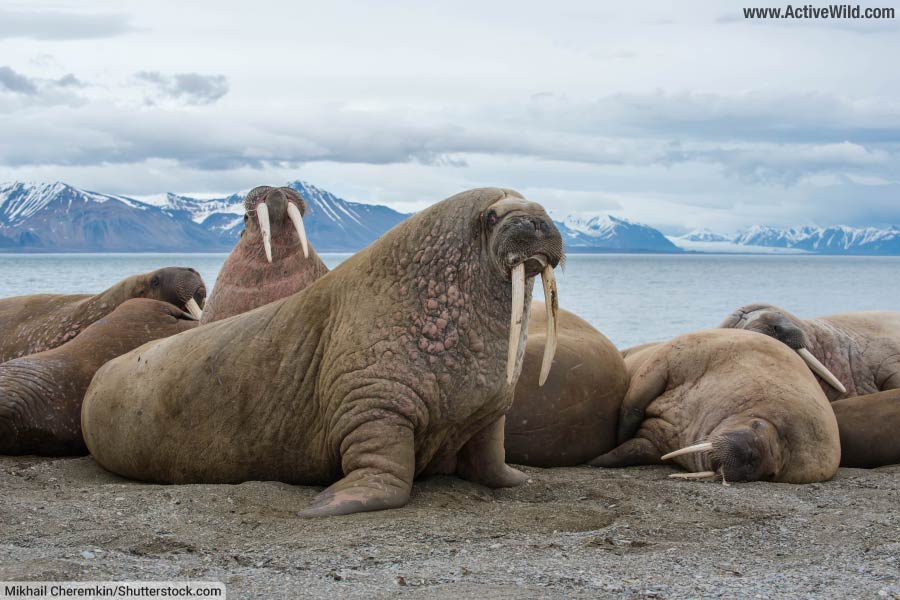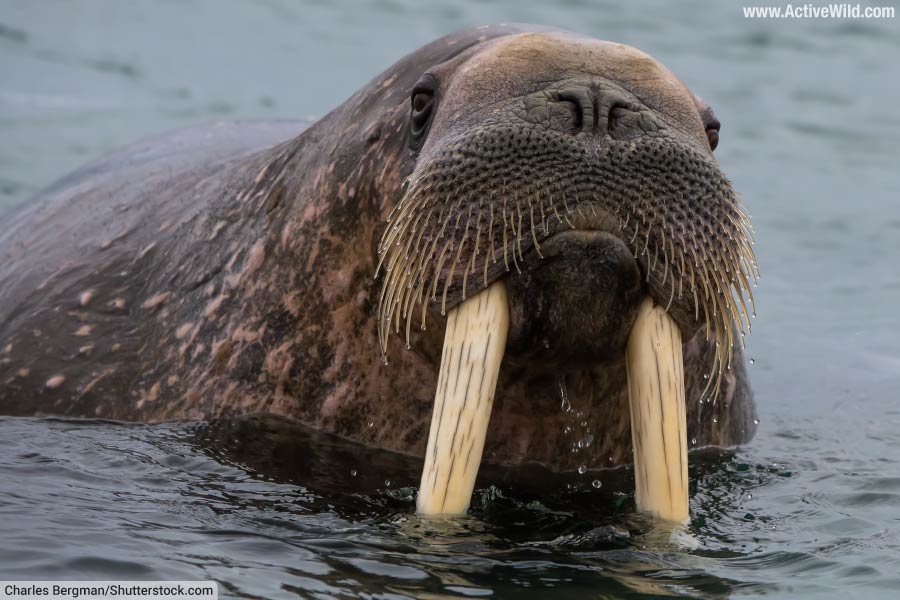Thor, the walrus who achieved celebrity status after visiting England in December, has recently been spotted closer to home. On Friday 24th February 2023, the wandering marine mammal turned up in Breiðdalsvík, a fishing town in East Iceland.
Walruses are seldom seen in Iceland, despite the country’s northerly location, and Thor may still have some distance to go before completing his journey. Some experts suggest he may have set off from as far away as the Canadian Arctic.
(Note: the photo at the top of this article is a stock image. You can see Thor himself in the videos further down the page.)

Page Index
Thor The "Wandering Walrus"
Thor is thought to be between three and five years old, which is still young for a walrus; the species can live up to 30 years in the wild. He is estimated to weigh around three quarters of a tonne (1,653.47 lb) and may still have some growing to do; adult male walruses typically weigh between 800 and 1,700 kg (1,764 and 3,748 lb.)
Throughout his travels, Thor appears to have been in good health. Scientists remain unsure as to what caused the adolescent marine mammal to embark on his 2,000 mile-plus journey.
Where Did Thor The Walrus Visit?
The opening date of Thor’s European tour took place in the Netherlands, where the walrus was spotted at Petten, and later on Neeltje Jans Island, on the 6th November 2022.
The tusked traveller then proceeded to swim westwards past Belgium to France, making an appearance in Dieppe on the 18th November.
After making his way along the French coast as far as Plouguiel in Brittany, Thor turned northwards to England, crossing the English Channel and hauling out up at Calshot, near Southampton, where he was spotted by fishermen early on Sunday 11th December.
Thor The Walrus In Scarborough
Thor’s journey continued anti-clockwise around the British coast, with his next port of call being Scarborough, a seaside resort in North Yorkshire. Here, on the evening of 30th December, Thor hauled out on the slipway of the town’s busy harbour, where he stayed for the night and much of the following day.
Thor’s appearance caused a sensation in the North Yorkshire town and received coverage in the national media, the walrus’s appearance looking incongruous against a backdrop of fishing boats and flashing Christmas lights.

So as not to distress to the resting walrus, it was decided that Scarborough’s New Year’s Eve firework display should be cancelled. Despite this, Thor’s visit was welcomed by the locals, who flocked to the harbour in their thousands to welcome their unusual guest.
The attention didn’t seem to concern Thor, who spent most of the day dozing, only stirring to move higher up the slipway as the tide rose.
Monitoring the situation at all times were members of the British Divers’ Marine Life Rescue (BDMLR), an organisation created specifically to assist in the rescue of marine animals.
Eventually, at around twenty past four, and under cover of the late afternoon darkness, Thor shuffled to the side of the slipway and slipped back into the ocean.
Two days later, on the 2nd January 2003, Thor turned up in Blyth, a coastal town in Northumberland some 75 miles north of Scarborough. This was the last time Thor was to be seen in England.
Thor The Walrus In Iceland
Almost two months later, on the 24th February, a walrus hauled out onto a floating pier in the fishing town of Breiðdalsvík, in east Iceland.
Comparison of markings on this walrus’s body with photos of Thor taken in the UK revealed that the animals were one and the same – Thor had reappeared to take yet another pit stop on his long voyage home.
Although Iceland is located on the edge of the arctic Ocean, it is still highly unusual for a walrus to be seen on the country’s coast.
Offering hope to those wishing Thor a safe return is the fact that Iceland is separated from Greenland – which does have a resident walrus population – by just 250 miles of ocean: a relatively small distance for an animal that has already covered upwards of 2,000 miles.
Perhaps, at this very moment, Thor is hauled out on a Greenland beach regaling other walruses with tales of his epic adventure – and of the kindness and consideration he was shown by humans along the way.
Walrus Sightings In The UK
Walruses are extremely rare in UK waters, with only around 27 sightings having been reported in the last 130 years.
The most recent walrus sighting (at the time of writing) in the UK occurred on Monday 27th February 2023, when a fisherman spotted a huge male walrus hauled out on the shore of the small island Cairn na Burgh Beag, part of the Inner Hebrides group off the west coast of Scotland.
Other walrus sightings in recent years include Wally, a young male walrus, who was seen in Ireland, Wales, England, France and Spain; and Freya, an older female, who visited several northern European countries, including the UK. Sadly, Freya was euthanized in Norway, the country’s authorities having decided that she was a danger to the public.
Top Walrus Facts

- The walrus is the only member of the family Odobenidae. Its scientific name is Odobenus rosmarus.
- The walrus has two subspecies: the Atlantic walrus (Odobenus rosmarus rosmarus), and the Pacific walrus (Odobenus rosmarus divergens).
- The walrus is the world’s third-largest pinniped. (A pinniped is a member of Pinnipedia, a group of marine mammals that is also home to all seals and sea lions.) Only the two species of elephant seal are larger than the walrus.
- The ancestors of all marine mammals were land animals that, over millions of years, evolved to live in the sea.
- A walrus’s tusks are elongated upper canine teeth.
- Both male and female walruses have tusks, although those of the male are longer and thicker.
- The tusks of a large male walrus can reach lengths of up to 1 m / 3.28 ft.
- A walrus uses its tusks to pull itself out of the water.
- The walrus’s whiskers, or vibrissae, are highly sensitive, and are used for foraging on the seabed.
- A walrus may have up to 700 vibrissae.
- The diet of the walrus consists mainly of bivalve molluscs, in particular clams, together with a wide variety of other marine organisms, including shrimp, crabs, and snails.
- The orca has only two natural predators: the polar bear and the killer whale / orca.
Discover More With Active Wild
- Discover more Arctic animals on this page: Arctic Animals List with Pictures & Facts
- Find out more about walruses on this page: Walrus Facts
- Read about the unexpected visit to London of another marine mammal: Beluga Whale Sighted In London

